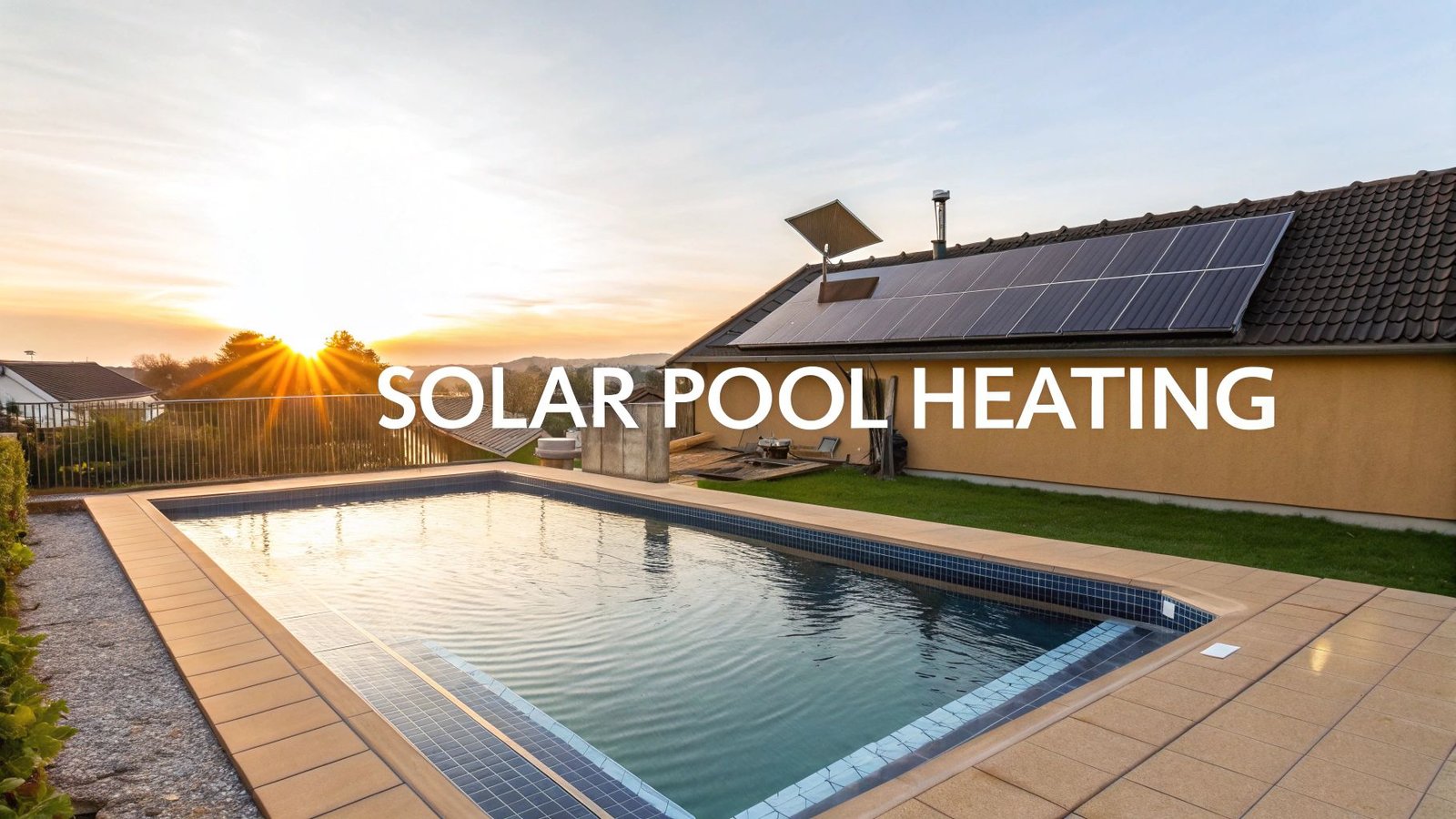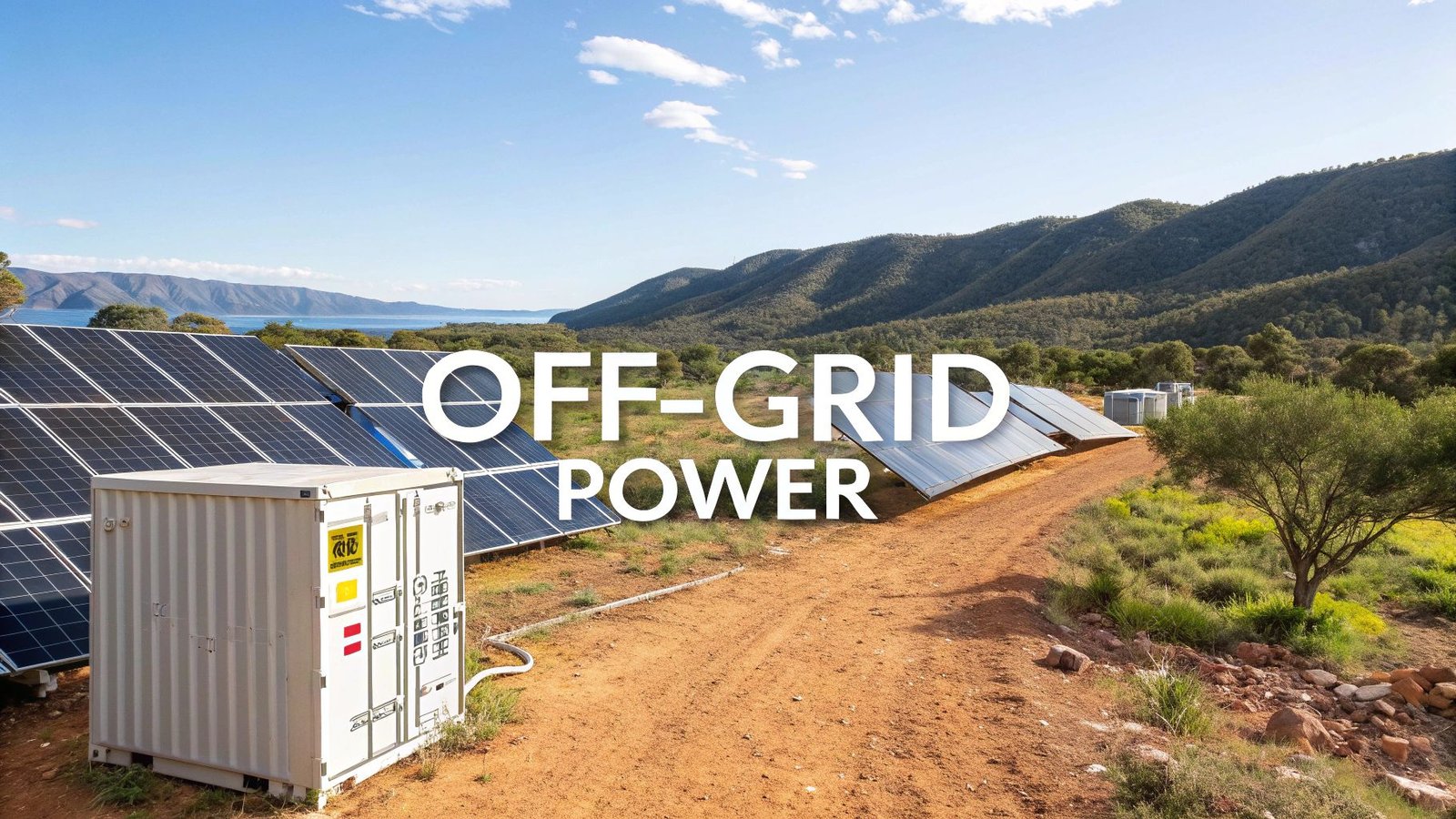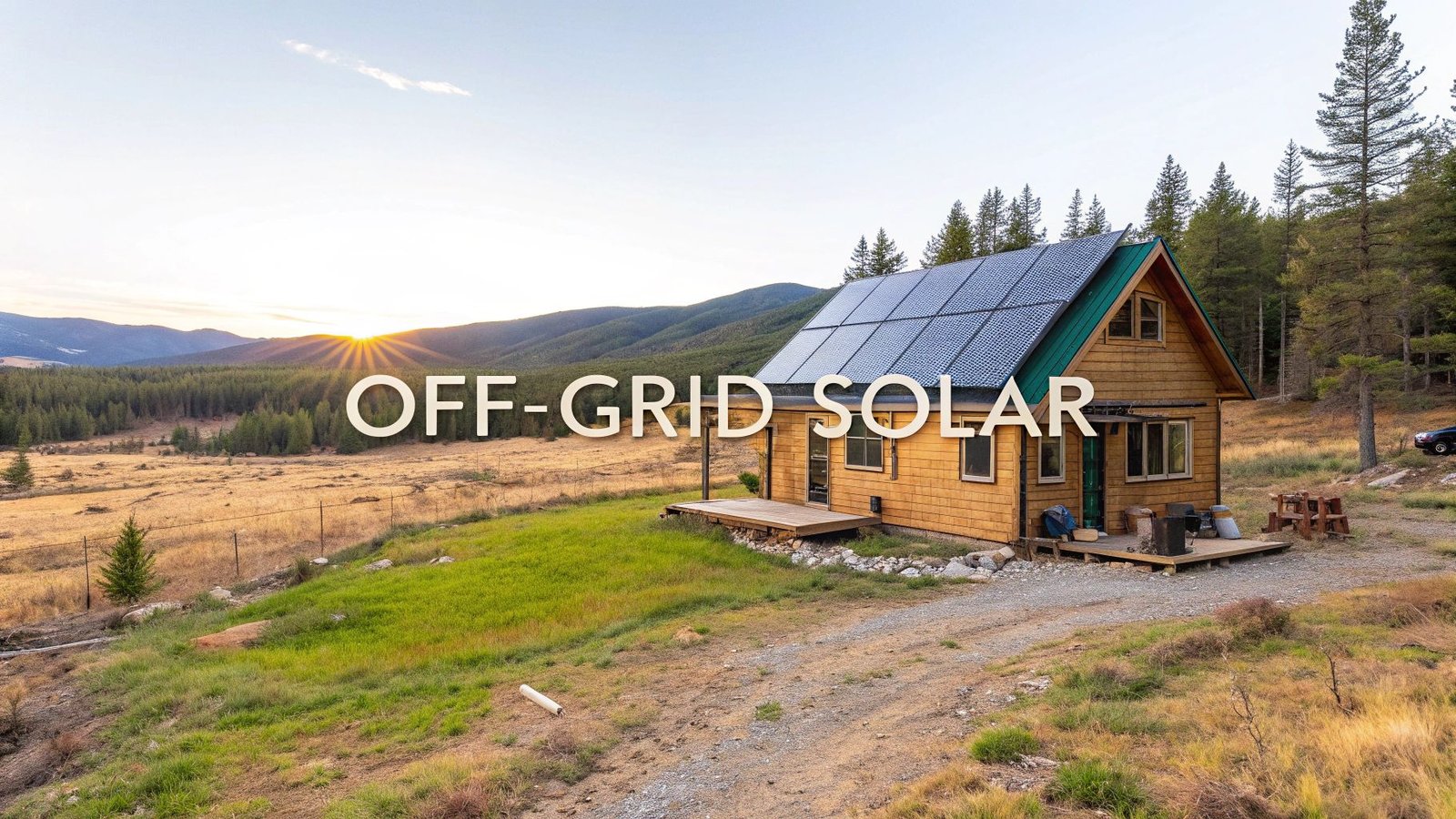Ever left a garden hose sitting out on a sunny day? That first blast of water that comes out is surprisingly warm. Solar heating for pools works on that very same, simple principle—just scaled up to be a lot more effective. It's a smart way to tap into the free, powerful energy of the sun to raise your pool's temperature, letting you swim comfortably for weeks or even months longer each year.
How Solar Pool Heating Warms Your Water for Free
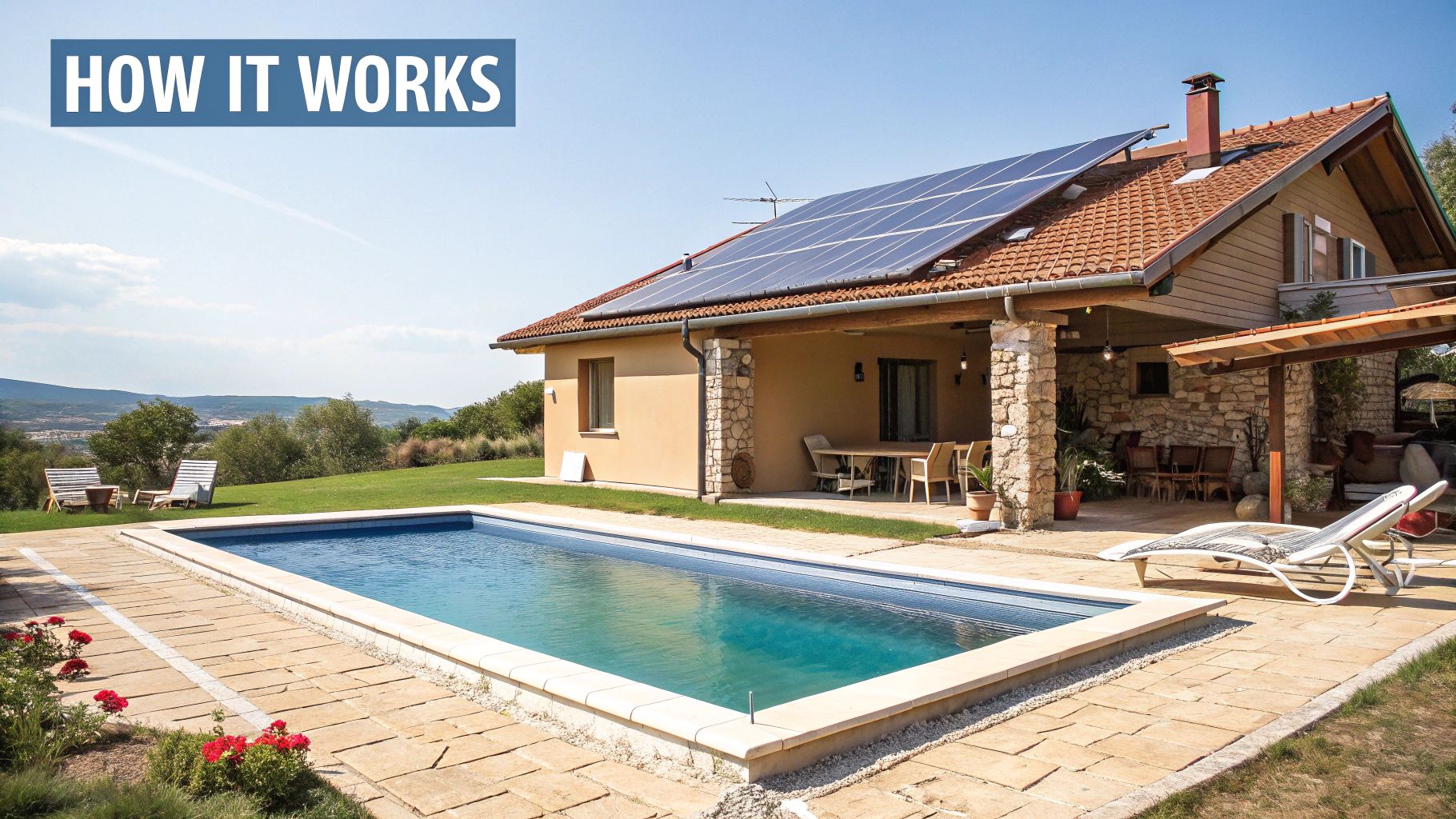
At its heart, a solar pool heating system is a brilliantly straightforward piece of tech that works right alongside your existing pool pump. It’s not complicated. Your pump simply pushes cool pool water up to a group of solar collectors, which are usually placed on your roof or another spot that gets plenty of sun.
As that water flows through a network of small tubes inside the collectors, it soaks up the sun's heat. From there, the newly warmed water heads right back into your pool, gradually raising the overall temperature. This all happens in a continuous, automated cycle that kicks on whenever the sun is strong enough to do its job.
For any pool owner tired of the steep operating costs of traditional heaters, this process is a game-changer.
The Financial and Environmental Edge
The biggest and most obvious win with solar pool heating is the massive drop in your energy bills. Once the system is installed, the sun's energy costs you absolutely nothing. This is a world away from gas or electric heaters, which can easily tack on hundreds—sometimes thousands—of dollars to your utility costs every single year.
Compared to a standard gas heater, a typical solar pool heating system can slash greenhouse gas emissions by an average of 6,000 pounds annually. That makes it the clear winner for any eco-conscious pool owner.
Beyond the savings, solar systems are incredibly kind to the environment. They produce zero emissions while they run, shrinking your home's carbon footprint. As more and more people look for greener ways to live, this kind of sustainable solution becomes more important than ever.
Understanding Your Options
While solar is a fantastic, cost-effective way to get warm water, it's good to know how it stacks up against different pool heating options. The main alternatives each have their own trade-offs when it comes to price, performance, and impact on the planet.
- Gas Heaters: These are the sprinters—they heat water very fast. But they come with the highest running costs and produce a lot of carbon emissions.
- Electric Heat Pumps: These are more efficient than gas heaters because they pull heat from the surrounding air. Their biggest drawback is that they don't work well when the air gets cold, and they still pull power from the grid.
- Solar Heaters: With virtually zero operating costs, this is the most environmentally friendly choice by a long shot. They do depend on sunshine, of course, but in most climates, they deliver consistent and reliable heat for a much longer swim season.
At the end of the day, going with solar is an investment in your home and the planet. It’s a choice that pays you back with decades of free, clean energy for a more enjoyable pool.
A Drop of Water's Journey Through a Solar Heater
To get a real feel for how elegantly simple solar pool heating is, let's trace the path of a single drop of water as it travels from your cool pool to the sun-drenched collectors and back again. It's a surprisingly straightforward cycle that works seamlessly with the equipment you already have.
The Starting Line: Your Pool Pump
Everything kicks off with your trusty pool pump, the workhorse that keeps your water circulating. During its normal filtering routine, the pump pulls our water droplet out of the pool, starting it on its warming adventure.
The "brain" of the system is a small automatic controller. This clever device constantly checks two things: the temperature of your pool water and the temperature up at the solar collectors on your roof. When it detects that the collectors are a good bit warmer than the pool, it flips a switch.
The Detour to the Roof
That switch activates a diverter valve—think of it as a railroad switch for your pool's plumbing. Instead of sending the water straight back to the pool after it’s been filtered, this valve reroutes our droplet, sending it on a detour up to the roof.
Once it reaches the roof, the water flows into the solar collectors. These aren't the same as solar electric panels. A better way to picture them is as a web of black, sun-absorbing tubes. Our water droplet travels through these narrow tubes, soaking up the sun's heat. The dark material is fantastic at capturing warmth and transferring it directly to the water flowing inside.
This is where the magic happens. The cool droplet is transformed into a warm one, purely from the sun's energy—no gas or extra electricity required for the heating itself. The whole setup is designed to be as efficient as possible, ensuring that by the time our droplet leaves the collectors, it's several degrees warmer.
The Warm Return
After its trip through the sun-soaked collectors, the newly warmed water heads back down through the return pipes. It flows back into your pool, mixing with the cooler water and gently raising the overall temperature, degree by degree. This loop runs on repeat all day long, as long as the sun is out and the collectors are hot.
This efficient, cost-free heating cycle is precisely why solar is booming. In fact, the global market for solar pool heating is projected to hit $1.5 billion by 2025, a clear sign that homeowners are embracing smarter, more sustainable solutions. You can discover more insights about this market's growth and what’s driving the trend.
The infographic below breaks down the three main phases of getting a system like this up and running, from the initial site check to connecting the final pipes.
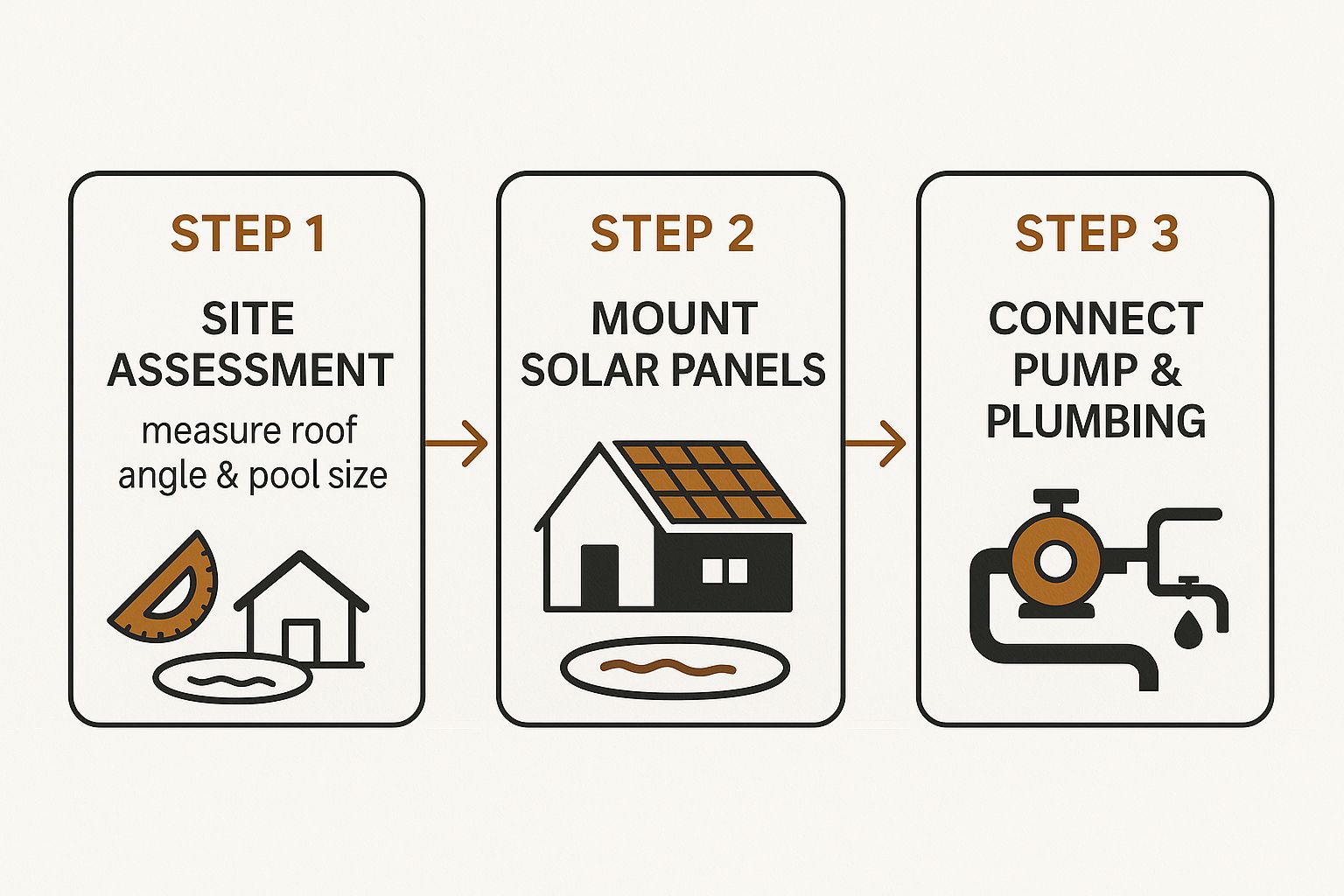
As you can see, a proper installation is a careful process. It's all about making sure the system is sized and configured perfectly for your pool and your home.
Picking the Right Solar Collector for Your Pool
When you're looking into solar heating for your pool, the collectors are the heart of the system. This is where the magic happens, and not all collectors are created equal. The right choice really comes down to where you live, what your budget looks like, and what you’re hoping to achieve. It’s a bit like buying a jacket—you wouldn't wear a light windbreaker in a blizzard.
There are three main players in the solar collector game: unglazed, glazed, and evacuated tube collectors. Getting to know the pros and cons of each is the key to investing in a system that you'll be happy with for years to come.
Unglazed Collectors: The Popular Workhorse
For most pool owners, unglazed collectors are the undisputed champion. These are typically simple, tough panels made of a black polymer or rubber that's built to withstand the sun's UV rays. Your pool water just pumps right through them, and the dark material soaks up the sun's energy, warming the water directly. Simple and effective.
This straightforward design is perfect for getting that moderate temperature boost most of us want in a swimming pool. They’re also the most budget-friendly option out there, which makes them a fantastic value, especially if you live in a place like Florida or Arizona where the sun is generous.
- Best For: Pool owners in areas where it doesn't get close to freezing during the swimming season.
- Key Advantage: You just can't beat the cost-effectiveness and durability for raising your pool's temperature by a comfortable 10-15°F.
Now, because they don't have a glass covering, they can lose a bit of heat on really windy or cool days. But for most situations, their efficiency in direct sun is more than enough to get the job done.
Glazed Collectors: For Cooler Climates
Glazed collectors are the next step up in heating power. These panels are built inside an insulated box and covered with a sheet of tempered glass. Think of it as a mini-greenhouse for your pool water—this design is fantastic at trapping heat and keeping it from escaping.
That extra insulation makes glazed collectors a much better pick for cooler, windier parts of the country. They're also great if you're trying to stretch your swim season into the crisp days of early spring and late fall. They do cost more upfront, but their ability to work well even when the air feels chilly can be a game-changer.
On a cool but sunny day, a glazed collector system will often keep working efficiently, giving you more swim time when an unglazed system might be struggling to make a noticeable difference.
This makes them a really solid choice for anyone in a region with unpredictable weather, giving you more consistent heating across a longer season.
Evacuated Tube Collectors: The High-Efficiency Powerhouse
At the very top of the performance mountain, you'll find evacuated tube collectors. These are the most advanced and efficient collectors you can buy. The design is pretty clever: each collector is a row of glass tubes, and inside each tube is another smaller tube with a vacuum-sealed space between them—just like your favorite thermos.
That vacuum is an incredible insulator, meaning almost no heat is lost to the outside air. Because of this, these collectors can get water much hotter than the other types and work amazingly well even when it’s freezing outside.
But all that performance comes with a hefty price tag. For just heating a backyard pool, evacuated tubes are usually overkill and not the most cost-effective choice. You’ll typically see them used for things like year-round domestic hot water systems or large commercial pools that need to stay at a high temperature no matter what.
Solar Pool Collector Comparison Guide
To make the decision a little easier, this table lays out the key differences between the three main types of solar collectors. It compares their features, costs, and where they shine brightest to help you find the perfect fit for your pool.
| Collector Type | Primary Material | Best Climate | Relative Cost | Key Advantage |
|---|---|---|---|---|
| Unglazed | Black Polymer/Rubber | Warm to Moderate | $ | Excellent value and durability for pools. |
| Glazed | Insulated Box w/ Glass | Cool and Windy | $$ | Better heat retention in colder weather. |
| Evacuated Tube | Glass Vacuum Tubes | Cold / All Climates | $$$ | Highest efficiency and cold-weather performance. |
For the vast majority of residential pools, the choice boils down to unglazed versus glazed. The affordable and reliable unglazed collector is the perfect match for sun-drenched states, while the glazed collector provides that extra performance boost for those of us in more temperate zones.
Calculating Your System Size and Potential Savings
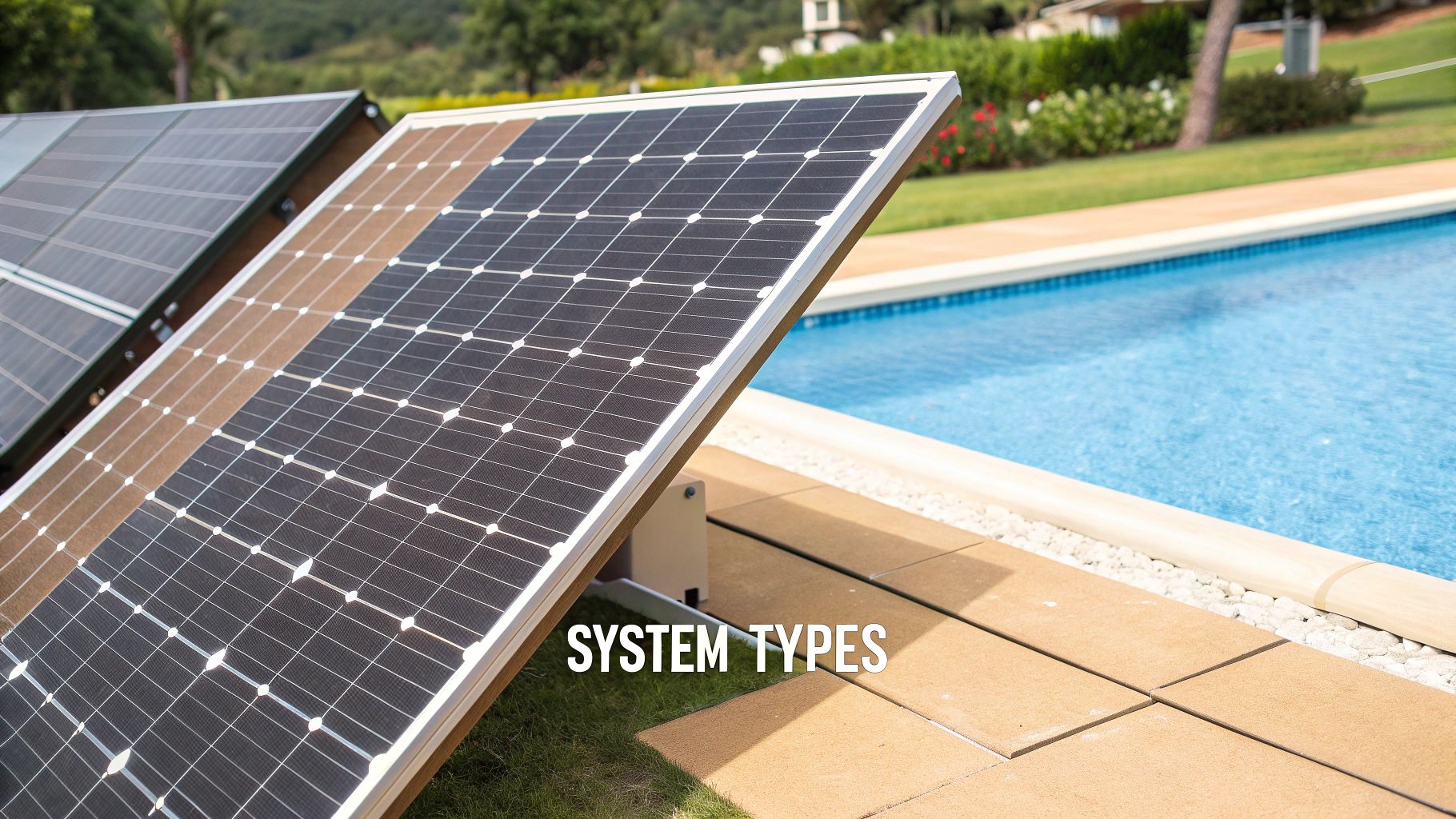
Nailing the right size for your solar pool heater is the most important part of the whole process. Get it right, and you'll have that comfortably warm pool you're after. Get it wrong, and you'll just be disappointed.
Many people assume sizing is all about how many gallons of water are in the pool, but that's not quite right. The real key is your pool's surface area. Think about it: that's where all the heat escapes, mostly through evaporation. So, to keep it warm, you have to counteract the heat loss at the surface.
A good starting point—a rule of thumb we use in the industry—is to aim for a solar collector area that's between 50% and 100% of your pool's surface area. So, if you have a 400-square-foot pool, you’re looking at a solar system between 200 and 400 square feet.
That’s a pretty big range, I know. But it gives us the flexibility to dial in the perfect size based on your specific situation.
Fine-Tuning Your System Size
Where you land in that 50-100% range depends on a few critical factors. A good installer will walk you through these to make sure your system is designed to perform perfectly.
- Your Desired Temperature: How warm do you really want it? If you're looking for a big jump of 10-15°F, you'll want to aim for a system closer to that 100% mark. If a milder 5-8°F boost is all you need, you can get away with a smaller system.
- Local Climate: It's no surprise that location matters. Here in sunny Florida or out in Arizona, you can often get fantastic results with a system sized at just 50-75% of the pool's surface area. But if you live in a cooler, cloudier region, you’ll need to get closer to 100% (or maybe even a bit more) to get the same warming effect.
- Roof Orientation and Shading: The ideal spot for solar collectors is a wide-open, south-facing roof. That’s where you get the most direct, powerful sunlight. If your only option is an east or west-facing roof, or if trees cast shadows during parts of the day, you’ll need more collector area to make up for the less-than-perfect exposure.
- Pool Usage and Environment: Is your pool out in an open, windy area? Wind is the enemy of a warm pool, so you’ll need to size up your system to compensate. On the flip side, if you're diligent about using a solar cover, you can often go with a slightly smaller system. That cover does an amazing job of trapping heat.
The right size isn't just about performance; it's about value. An undersized system will leave you frustrated, while an oversized one means you've spent more than you needed to. A careful calculation ensures you hit that sweet spot of cost and comfort.
The Financial Payoff and Long-Term Savings
Once you have an idea of the right size, the conversation naturally turns to cost and—more importantly—return on investment. You can expect the upfront cost for a professionally installed solar pool heating system to be somewhere in the $3,000 to $6,000 range. The final price tag depends on the system size and how complex the installation is.
While that initial cost might seem on par with some gas or electric heaters, the real story is what happens over the long haul. If you're curious about solar costs in general, our article on the solar panel system installation cost provides a great overview.
The magic of solar heating for pools is that it costs almost nothing to run. After the installation, the sun does all the work for free. This is a world away from gas and electric heaters, which are constantly burning through expensive fuel or electricity just to keep your pool warm.
This is part of a bigger trend, too. People are moving toward more sustainable solutions at home. The entire pool heating market is projected to be worth around $2.9 billion in 2025 and is expected to balloon to nearly $8.5 billion by 2033. That kind of growth shows just how much demand there is for efficient options like solar. You can dig into the numbers yourself by exploring the full market research on pool heating systems.
Let's put some real numbers to it. Here’s a look at the estimated 10-year operating costs for an average residential pool heater.
| Heater Type | Initial Cost (Avg.) | Annual Operating Cost (Avg.) | 10-Year Total Cost |
|---|---|---|---|
| Solar Heater | $4,500 | ~$50 (Pump) | ~$5,000 |
| Electric Heat Pump | $3,500 | ~$900 | ~$12,500 |
| Gas Heater | $3,000 | ~$1,800 | ~$21,000 |
The table makes it pretty clear. A solar heater usually pays for itself in energy savings within just 3 to 7 years. After that break-even point, you’re looking at more than a decade of free heat. That adds up to thousands of dollars in savings and brings real, sustainable value to your home.
Getting it Installed Right and Keeping it Running Smoothly
When it comes to solar heating for pools, getting two things right makes all the difference: a rock-solid professional installation and a dead-simple maintenance plan. Nail the setup from the start, and you'll soak up every bit of free energy the sun offers. A little bit of easy upkeep then ensures your system keeps chugging along for its entire 15-20 year lifespan.
The installation isn't just about throwing a few panels on the roof. It’s about strategy. A good installer is going to spend time analyzing your specific property before they even think about touching a pipe.
What a Pro Looks for During Installation
Where your solar collectors go is probably the single most important decision. Here in the northern hemisphere, a south-facing roof is the ideal spot because it gets the most direct sun all day long. But don't worry if that's not an option; east or west-facing roofs can work just fine, you might just need a slightly larger system to get the same results.
Beyond just the direction, installers will zero in on:
- Roof Angle: The pitch of your roof plays a big role in how well the collectors catch the sun's rays. The perfect angle is often pretty close to your geographic latitude.
- Structural Health: Your roof needs to be sturdy enough to handle the weight of the collectors. They aren't incredibly heavy, but they need to be mounted securely for the long haul.
- Shading Issues: A real pro will do a shading analysis, looking for anything—trees, a chimney, a neighbor's new addition—that could cast a shadow on your collectors during the sunniest parts of the day.
While a weekend DIY project might sound appealing, this is one area where calling in a professional pays off. They know how to avoid the common mistakes like bad plumbing connections, roof leaks, or just a poorly designed layout that kills your efficiency. An expert makes sure everything works together perfectly to generate the most heat possible.
Your Simple Seasonal Upkeep Plan
Here’s the best part: once your solar heater is installed, it pretty much takes care of itself. Forget about servicing burners and pilot lights like you would with a gas heater. A solar system has very few moving parts, so a little bit of attention once a year is all you need to keep it in tip-top shape.
Think of solar pool heater maintenance as a quick seasonal check-up, not a major chore. A few simple steps each year are all you need to protect your investment and ensure decades of free, reliable heat.
This quick check-in prevents small issues from turning into big, expensive headaches down the road. For more general tips, a good solar panel maintenance checklist can be a great resource for overall solar care.
Annual Maintenance Checklist
Here's a quick and easy checklist to run through. The main goals are just to make sure water is flowing freely and the system is secure.
| Task | Frequency | Why It's Important |
|---|---|---|
| Inspect Collectors | Annually | Look for any debris, cracks, or general wear. Give the mounting hardware a quick check to make sure it's tight. |
| Check for Leaks | Annually | Glance over the plumbing connections on the roof and down by your pool equipment. A small drip is easy to fix. |
| Clean Pool Filter | Regularly | This is a big one. A clogged filter makes your pump work way too hard and slashes your heating efficiency. |
| Winterize System | Seasonally (in cold climates) | If you get freezing winters, you'll need to drain the water from the collectors and pipes so they don't crack. |
That’s pretty much it. Follow this simple routine, and you can rest easy knowing your system will keep delivering a warm, comfortable pool for years to come, all powered by nothing but sunshine.
How to Get the Most Out of Your System
Putting in a solar heater is a great start, but how you run it makes all the difference. Think about it this way: your solar system is constantly adding heat to the pool, but the open air is constantly trying to steal it away. If you can slow down that theft, your system doesn't have to work nearly as hard.
The biggest game-changer here is incredibly simple: use a solar pool cover. It’s like putting a lid on a pot of boiling water. All that warmth your system worked so hard to create gets trapped right where you want it—in the pool. This one move makes a massive difference in how well your heater performs.
The Power of a Solar Cover
Believe it or not, the main way your pool loses heat is through simple evaporation. A solar cover sits right on the water's surface and stops that process cold, cutting heat loss from evaporation by over 70%.
That means the water stays warmer, longer. It’s the key to keeping your pool comfortable overnight and on breezy days when an uncovered pool would lose several degrees of precious heat. If you're looking for the right fit, you can explore our guide to find the best solar pool covers for your setup.
This push for efficiency isn't just a backyard trend; it's a global one. Solar thermal technology, which is the category solar pool heaters fall into, has exploded in popularity. The total installed capacity worldwide jumped from a mere 62 GW thermal in 2000 to roughly 544 GW thermal by 2024. That's almost a nine-fold increase, showing just how many people are turning to smart solar heating. Read the full research about these solar heating findings to dig into the data yourself.
This chart really drives the point home, showing just how much heat an uncovered pool loses compared to one with a cover.
It's clear that covering your pool prevents your solar system's hard work from just vanishing into thin air.
Smart Ways to Run Your System
Beyond a cover, a few small tweaks to your daily routine can squeeze even more warmth out of the sun. It really all comes down to timing.
The secret is to run your system only when it's a "net positive"—when the collectors on your roof are actually hotter than the water in your pool. If you run it at the wrong time, you can accidentally turn your heater into a pool cooler.
An automatic controller is the best tool for the job here. It uses sensors to compare the collector and pool temperatures, so the pump only sends water to the roof when it's guaranteed to come back warmer. It takes all the guesswork out of the equation.
The other piece of the puzzle is your pump schedule. For solar heating for pools to work its magic, you need to run the pump when the sun is at its strongest.
- The Sweet Spot: Aim to run your pool pump during peak sun, usually between 10 a.m. and 4 p.m.
- Avoid Off-Hours: Firing up the system early in the morning or late at night when the roof is cool can actually pull heat out of your water.
- Tweak with the Seasons: You'll likely need to run the pump a bit longer in the spring and fall to hit that perfect temperature.
When you combine the heat-trapping effect of a solar cover with a smart, automated pump schedule, you’re creating the perfect system. Every bit of solar energy gets captured and stored, letting you swim comfortably for as long as possible.
Common Questions About Solar Pool Heating
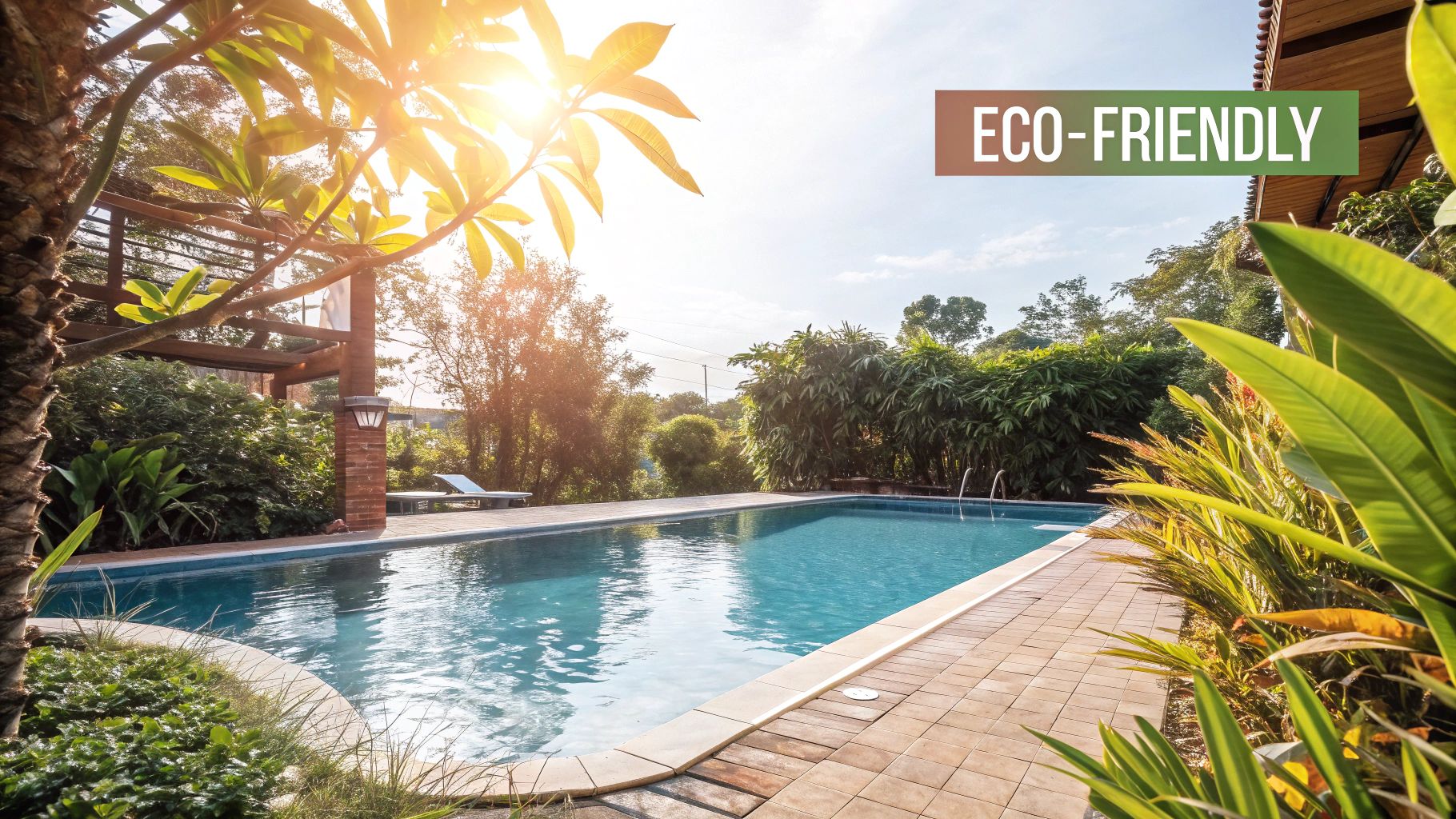
Even with a good grasp of how solar pool heaters work, it's completely normal to have a few more questions pop up before you're ready to commit. Let's walk through some of the most common things I hear from homeowners, breaking them down into clear, straightforward answers to help you feel confident about your decision.
How Much Warmer Will My Pool Get?
This is usually the first question on everyone's mind. A professionally sized solar pool heater will typically give you a 10 to 15 degree Fahrenheit (that's about 5 to 8°C) boost over an unheated pool.
Of course, the exact temperature lift depends on your climate, how much direct sun hits your collectors, and—this is a big one—whether you use a solar cover at night. For most people, that 10-15 degree jump is the sweet spot that transforms a bracingly cold pool into a comfortable oasis, extending your swim season by months.
Do Solar Heaters Work on Cloudy Days?
They do, just not at full power. Think of it this way: solar collectors are designed to absorb any solar radiation they can get, which includes both direct sunlight and the diffuse, ambient light that makes it through the clouds. So, they'll still provide some warmth on an overcast day.
But let's be realistic. During a heavy downpour or on a day with thick, dark cloud cover, the heating effect will be pretty minimal. This is exactly why an automatic controller is so important; it’s smart enough to know when to stop pumping water to the roof, so you don't accidentally cool your pool down.
What Is the Lifespan of the System?
Here’s where solar really shines. The collectors—the heart of the system—are built tough from UV-resistant materials and routinely last 15 to 20 years. In fact, it's not uncommon to see systems still going strong well past the two-decade mark.
One of the biggest advantages of solar pool heating is just how long the equipment lasts. The collectors themselves are incredibly durable, often lasting 15 to 20 years or more.
Because there are so few moving parts, these systems are a true long-term investment. They're built to provide free, reliable heat for decades, paying for themselves in energy savings and then some.
Will I Need to Upgrade My Pool Pump?
Probably not. In my experience, most modern pool pumps have more than enough muscle to handle the job of pushing water up to the roof and through the solar collectors.
When a professional comes out for an assessment, they'll check your pump's flow rate against the height of your roof. Only in rare cases—maybe an older, underpowered pump or an unusually high roofline—would a small, inexpensive booster pump be needed. For more information on pool equipment and maintenance, you can check out these general pool FAQs.
When you add it all up—significant temperature gains, reliable performance, and incredible durability—solar becomes a pretty practical and compelling choice for any pool owner.
Ready to enjoy a warmer pool with zero energy costs? At Radiant Energy, we design and install high-quality solar pool heating systems tailored to your home and budget. https://radiantenergysolar.com

